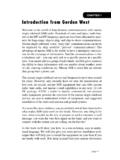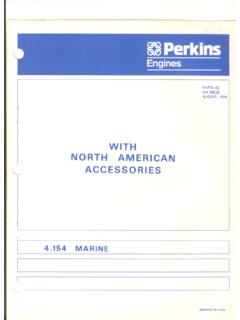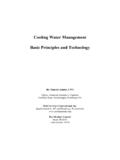Transcription of Marine Grounding Systems - kp44.org
1 1 Marine Grounding Systems This article was originally published in the October 15, 1996 issue of Practical Sailor. The author, Stan Honey, is a renowned sailor, navigator and electrical engineer. Marine Grounding Systems ground n. 12. Electricity A. A large conducting body, such as the earth or an electric circuit connected to the earth, used as an arbitrary zero of potential. In a normal house on land, the problem of Grounding is simple. It consists of the green Grounding wire in the AC wiring system and serves the purpose of preventing shocks or electrocution. The ground connection is usually made by clamping to a metal water pipe or by driving a long copper stake into the ground. On a boat, things are considerably more complicated.
2 In addition to the AC ground, we need a DC ground or return line, a lightning ground, and a RF ground plane for the radio Systems . Our first thought might be to simply make the ground connection to a metal thru-hull, propeller shaft or other underwater metal. This underwater metal will be grounded by connection to the seawater will serve as our water pipe . Unfortunately, a connection between any of these Systems and underwater metal can, and probably will, give rise to serious electrolytic corrosion problems. This article will discuss the particular requirements of each system , resolve the contradictions between the Systems and present a consistent and correct solution for a complete, integrated, Marine Grounding system .
3 Figure 1. The boats electrical system should be connected to seawater at one point only, via the engine negative terminal or its bus. DC Ground Every light or appliance should be wired with its own DC return wire. Never use the mast, engine, or other metal object as part of the return circuit. The DC load returns of all branch circuits should be tied to the negative bus of the DC distribution panel. In turn, the negative bus of the DC distribution panel should be connected to the engine negative terminal or its bus. The battery negative is also connected to the engine negative terminal or its bus. The key factor here is that the yacht's electrical system is connected to seawater ground at one point only, via the engine negative terminal or its bus.
4 See figure one. 2 AC Ground See Practical Sailor August 15, 1995 for a detailed treatment of the green wire. The best solution is a heavy and expensive isolation transformer. The acceptable solution (for the rest of us) is to install a light and inexpensive Galvanic Isolator in the green wire, between the shorepower cord socket on your boat, and the connection to the boat's AC panel. Then, connect the Grounding conductor (green) of the AC panel directly to the engine negative terminal or its bus. Note that this meets the ABYC recommendation. In choosing Galvanic Isolators, make sure that you select one that has a continuous current rating that is at least 135% the current rating on the circuit breaker on your dock box.
5 Certain Galvanic Isolators ( Quicksilver) include large capacitors in parallel with the isolation diodes, which in certain situations theoretically provide better galvanic protection. Unfortunately, these units cost substantially more than conventional Galvanic Isolators. If you feel like spending real money on galvanic isolation, you might as well do it right and buy an isolation transformer. It is also a good idea to use a Ground Fault Circuit Interrupter (GFCI) in your AC wiring. GFCI's will occasionally "nuisance trip" due to the humidity surrounding the wiring on boats, but the additional safety that they offer (particularly to nearby swimmers) in disconnecting power in the presence of ground currents is worth the nuisance.
6 If your GFCI starts to nuisance trip, it is probably a very good idea to track down and clean up your damp wiring in any event. Figure 2. Ground fault circuit interrupters (GFCI) should be installed in each AC circuit. A GFCI will disconnect power in the presence of ground currents, helping prevent an electrocution. Lightning Grounds Connect a 4 AWG battery cable from the base of your aluminum mast to the nearest keel bolt from external ballast. If you have internal ballast, you should install a lightning ground plate. One square foot is recommended for use in salt water; fresh water requires much more. Do not rely on a thru-hull or a sintered bronze radio ground ( Dynaplate) for use as a lightning ground. For additional comfort, also run a 6 AWG wire from your keel bolt or ground plate to the upper shroud chainplates, and to your headstay chainplate.
7 Don't bother with the backstay if it is interrupted with antenna insulators. Have each of the cables that are used for lightning ground wires lead as directly as possible to the same keel bolt, with any necessary bends being smooth and gradual. Given that you have grounded your mast solidly to the ocean, your mast will be at exactly the same electric potential as the ocean. There is no chance that you can dissipate the charge 3 between the ocean and the atmosphere, so don't bother with a static dissipater at the masthead. Wire "bottle brush" static dissipaters may be useful to dissipate seagulls, however, but that is beyond the scope of this article. RF Ground Your VHF doesn't need to use the ocean as a counterpoise, so here we are dealing only with the ground needed for your HF/SSB radio.
8 Mount your automatic tuner as close to the backstay as possible, preferably just under the after deck. Run copper ground tape from the tuner to the stern pulpit/lifelines, to the engine, and to a keel bolt. It is good practice to include the HF/SSB radio itself in this network of ground tapes. If the builder of your yacht had the foresight to bond into the hull a length of copper tape or an area of copper mesh, be sure to run a copper ground tape to this as well, and say a blessing for builders such as these. Sintered bronze ground plates ( Dynaplates) can be used as radio grounds in situations where the ballast or engine is unavailable or awkward to connect. If the ballast, engine, and lifelines are available, however, they generally make a high performance ground.
9 Bonding and Electrolytic Corrosion Due to Hot Marinas Do not bond any thru-hulls or other immersed metal that can be electrically isolated. Specifically, keep your metal keel/ballast, your metal rudder shaft, your engine/prop, and all thru-hulls electrically isolated, from each other, and from the engine. It's worth understanding the reason. In an increasing number of marinas, there are substantial DC electric currents running through the water. If your bits of immersed metal are bonded, the electric current will take the lower resistance path offered by your boat in preference to the water near your boat, and the current will flow into one of your bits of metal, through your bonding wires, and then out another bit of metal.
10 The anodic bit of metal or thru-hull that has the misfortune to be on the "out current" side of the current running through your bonding system will also become "out metal" and will disappear, sometimes rapidly. Your zinc is only intended to protect against the modest galvanic potentials and therefore currents that are caused by the dissimilar metals that are immersed and electrically connected together on your own boat. Your zinc is incapable of supplying enough galvanic potential to protect against substantial DC currents that may be flowing in the water. These DC currents in the water will cause electrolytic corrosion to your bonded thru-hulls or metal parts. Zincs and Protection from Galvanic Corrosion Use zincs to protect against the galvanic currents that are set up by dissimilar metals on your boat that are immersed and that are in electric contact with one another.










